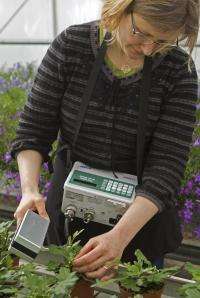How exposure to irregular light affects plant circadian rhythms

Scientists know that plants can actually "sense" day length, and "schedule" their growth to coincide with specific environmental conditions. These natural events are based on the circadian clock, a 24-hour system found in most biochemical and physiological processes. Plants grow better in circadian conditions that correspond to natural environments, but until now researchers have not understood how plants' internal circadian clocks respond to irregular lighting environments such as those found in many greenhouses.
Greenhouses in northern latitudes rely heavily on supplemental light sources to extend the number of light hours during the day. To conserve electricity and lower costs, newer low-energy input systems use lights only during less expensive off-peak hours and turn lighting off during peak load periods in the afternoon and in the morning. These systems, though more cost-effective than conventional lighting methods, create irregular lighting patterns of natural sunlight interrupted with artificial lighting—a challenge for both growers and plants.
Danish scientists Katrine Heinsvig Kjaer and Carl-Otto Ottosen from the Department of Horticulture at Aarhus University published a study in a recent issue of the Journal of the American Society for Horticultural Science that sheds light on the question of plants' response to interruptions in lighting cycles. "Circadian rhythms are believed to be of great importance to plant growth and performance under fluctuating climate conditions. However, it has not been known how plants with a functioning circadian clock respond to irregular light environments that disturb circadian-regulated parameters related to growth", they explained.
For their experiments, the team used 300 cuttings of chrysanthemum (Chrysanthemum morifolium 'Coral Charm') grown in 19 hours of light for 2 weeks. The plants were then randomly placed in either of two greenhouse compartments with similar temperatures and carbon (CO2) concentration. "The plants were exposed to supplemental light provided as irregular light breaks during the night, which we achieved by controlling the light based on forecasted solar irradiance and electricity prices', explained the authors. "Growth, in terms of carbon gain, was linearly correlated to both day length and daily light integral."
The scientists observed that chrysanthemum plants grown in short days with irregular light breaks during the night showed more rapid leaf development and stem growth than plants grown in a climate with a consecutive long light period, proving that low average light intensity promotes expansion of the photosynthetic area of the plants. Though the experiments showed that irregular light periods disturb circadian rhythm and induce changes in leaf characteristics, the authors noted that the study also proved that plants can naturally adapt to irregular light periods.
Kjaer and Ottosen say their research should help greenhouse operators realize energy savings in the area of supplemental light usage.
More information: The complete study and abstract are available on the ASHS Journal of the American Society for Horticultural Science electronic journal web site: journal.ashspublications.org/c … ent/abstract/136/1/3
Provided by American Society for Horticultural Science















